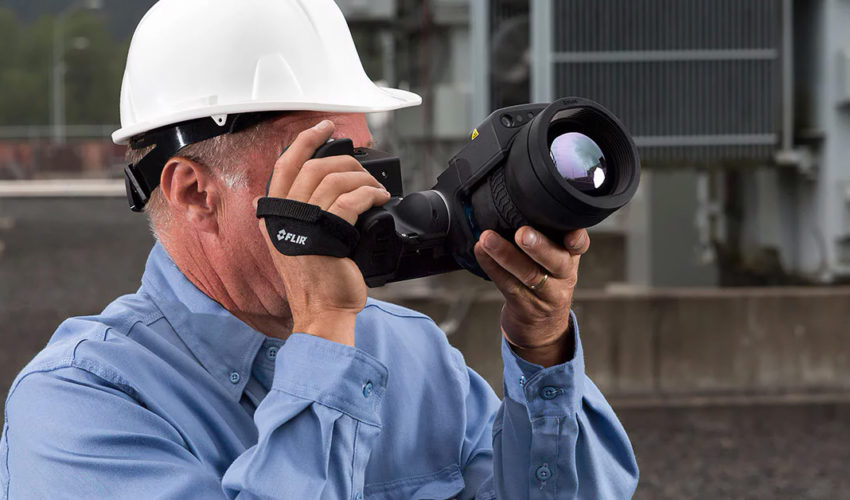In modern industrial settings, acoustic imagers enhance inspection processes and operational efficiency. However, integrating acoustic imagers with cutting-edge technology can significantly elevate their effectiveness and utility. Whether you are interested in monitoring gas leaks, assessing structural integrity, or optimizing thermal anomaly detection, integrating these advanced technologies empowers industrial operations to achieve a whole new level of efficiency and peace of mind by enhancing data accuracy, enabling proactive maintenance, and supporting regulatory compliance across diverse industrial applications.
1. Advanced Image Rendering Tools
Advanced acoustic cameras seamlessly integrate acoustic data with live digital or thermal images, revolutionizing industrial inspections. Inspectors comprehensively understand equipment conditions by overlaying real-time acoustic data onto these images. Such integration is crucial in leak detector air systems for precise localization of sound sources within the visual context, facilitating swift identification of anomalies such as air leaksor mechanical vibrations.
For instance, during a compressor inspection, the camera overlays acoustic data onto a thermal image, highlighting specific areas where unusual sounds are detected. The real-time overlay enhances diagnostic accuracy and expedites decision-making on maintenance actions, optimizing operational efficiency and reducing downtime in industrial environments.
2. Spectral Analysis and Visualization Technologies
Spectral analysis is crucial in visualizing and interpreting acoustic signals in industrial applications. It involves analyzing acoustic signals’ frequency components to distinguish between sound signatures, such as air leaks, mechanical vibrations, or structural anomalies.
Acoustic cameras equipped with advanced software for spectral analysis convert these frequencies into visual colors through colorization within the acoustic image.The capability helps inspectors and maintenance personnel quickly identify and distinguish specific types of acoustic anomalies based on their unique frequency patterns.
For example, high-frequency hissing indicative of a gas leak might appear as a distinct color pattern on the acoustic image, enabling precise localization and immediate corrective action. It enhances diagnostic accuracy while supporting proactive maintenance strategies by detecting early warning signs of equipment malfunctions.
3. Automatic Reporting Tools
Acoustic imaging cameras seamlessly integrate with software that supports automated reporting, enhancing inspection efficiency. These software features generate detailed reports based on inspection data, including sound signature analysis, location identification, and severity assessments. Advanced plugins allow for the import of acoustic images from cameras into the analysis software, where users can edit, analyze, and create comprehensive reports.
These reports capture critical information such as the type and location of anomalies, frequency patterns, and severity levels. Automated reporting saves time, ensures consistency, and facilitates clear communication with maintenance teams. That helps expedite repairs and implement effective solutions, enhancing operational efficiency and reliability.
Clear, well-detailed, and professional reports help your customers understand thermal camera inspections and the problems relating to their equipment, reinforcing the value and reliability of the inspection services you provide.
4. Machine Learning for Enhanced Defect Identification
Integrating machine learning into acoustic imaging software empowers the system to learn and recognize patterns in sound data, leading to more accurate anomaly detection and improved classification of issues. For example, machine learning can differentiate between air leaks and steam leaks or analyze sound patterns for leak and electrical discharge (PD) detection.
These advanced algorithms refine the analysis, resulting in more precise and reliable detection. That reduces the risk of false positives while ensuring efficient maintenance efforts. By continuously learning from new data, the system becomes increasingly adept at identifying defects, optimizing maintenance schedules, and enhancing overall operational efficiency in industrial environments.
5. OTA (Over-The-Air) Software Updates
Keeping all your acoustic cameras updated with the latest software is crucial for optimal performance. However, not all cameras are compatible. Hence. Ensuring that you purchase a camera with these capabilities is vital. OTA updates come with several advantages, which include the following:
- Automatic Updates: Deploy new software versions to all cameras wirelessly, ensuring everyone is on the same page without needing manual intervention.
- Improved Functionality: With OTA updates, you can benefit from quick bug fixes, new features, and enhanced performance across your camera fleet, maintaining cutting-edge capabilities.
- Reduced Downtime: Avoid taking individual cameras offline for manual updates, minimizing disruptions to inspection workflows.
Using OTA updates is an easy way to update your cameras with the latest improvements. For example, when you connect your FLIRcamera to the internet, it automatically receives and installs updates, ensuring it always operates with the most current and reliable software. The seamless process enhances efficiency and provides consistent performance across all devices in your fleet.
6. Cloud Data Integration
Acoustic imaging cameras collect valuable information that serves multiple purposes and users. Hence, the storage and accessibility of these images and reports are crucial for practical use. Advanced acoustic cameras can integrate seamlessly with cloud platforms, addressing the challenges of handling data from numerous devices.
Advantages of cloud integration include:
- Centralized Storage: Store all your acoustic data securely in a central cloud repository, ensuring it is safe and well-organized.
- Enhanced Data Accessibility: Access and analyze data from any location with an internet connection, facilitating remote monitoring and decision-making.
- Scalable Storage: Easily expand storage capacity as the number of cameras and data volume grows, accommodating your expanding inspection needs.
The integration simplifies data management, enhances collaboration, and supports efficient maintenance strategies across industrial operations.
7. Fleet Management Feature to Monitor Your Cameras
Imagine having dozens or even hundreds of acoustic cameras deployed across your facilities. Fleet management features allow you to monitor the health and status of each camera centrally. That eliminates the need for physical checks at each camera, saving significant time and resources. That includes aspects like:
- Inventory Management: Track the location, model, and operational status of all your cameras, ensuring you know exactly where each device is and how it’s performing.
- Performance Monitoring: Monitor battery levels, uptime, and potential issues with each camera, enabling proactive maintenance and minimizing downtime.
- Automated Updates: Remotely deploy software updates and configuration changes to all cameras simultaneously through OTA updates. That eliminates the necessity to visit each camera individually, saving significant time and effort.
These capabilities enhance efficiency, reduce manual oversight, and ensure optimal performance of your acoustic imaging equipment.
In conclusion, whether inspecting HVAC systems, underground utilities, electrical systems, or troubleshooting building insulation problems, upgrading to modern acoustic imaging cameras with advanced tech integration capabilities enhances inspection accuracy, efficiency, and maintenance efforts. However, it’s essential to identify a reliable camera brand offering versatile and robust software support. That ensures seamless operation, timely updates, and comprehensive data management, ultimately leading to improved operational performance and reduced downtime.



